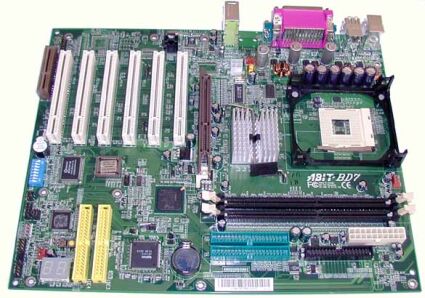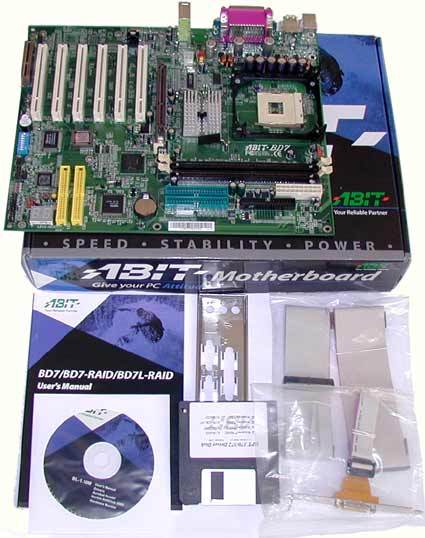Intel's Strike Force: 19 DDR-Motherboards With 845 Chipset and DDR-Support
ABit BD7-RAID
Board Revision: ?
BIOS Version: November 6, 2001
Here, ABit takes one step back, not in terms of features or technology, but in terms overclockability: both the RDRAM motherboards TH7-II and the BD7-RAID that we tested here are able to run the next generation Pentium 4 models, clocked at 133 MHz FSB (533 MHz quad-pumped). Other motherboards can do this, too, but none of them are able to run the PCI, AGP and the main memory synchronously, as does the BD7-RAID.
The BIOS includes Abit's SoftMenu III, which lets you set all important CPU parameters. Theoretically, Abit allows up to 250 MHz FSB, although it's a bit idealistic to think that this could ever work - maybe in another few years! In real life, approximately 180 MHz FSB is the absolute limit. And this can be achieved with high-quality memory and frequency-tolerant components.
This board comes with an IDE RAID controller chip from HighPoint (HPT372), supporting four additional IDE drives or hard drives in RAID 0, 1 or 0+1. Users looking towards technology of the future will love to hear that UltraATA/133 is already supported by this controller. This ensures that at least two more generations of drives can be addressed without a bottleneck in the interface.
Unfortunately, the connectors for the RAID chip are placed inconveniently, since standard cables at 40 cm won't reach the top bays of huge tower cases. Abit includes an ATX cover for the connectors, since they have been re-arranged and thus won't fit into the regular ATX standard.
Two DIMM slots aren't much, but it should be enough for most of us. A little comfort could be taken by the fact that you will get six PCI slots in the end.
Get Tom's Hardware's best news and in-depth reviews, straight to your inbox.
Taking a glance into the box, it seems as if Abit has not left anything out. There is a detailed manual, a CD with the latest drivers and utilities for the motherboard and the sound system, and last but not least a floppy disk containing the RAID controller's drivers for the typical Windows operating systems. This disk is important when installing Windows 2000 or Windows XP: neither of the systems support this RAID controller, because it is simply too new. The picture also shows the ATX cover, a floppy, an 80-pin IDE cable and a game port adapter cable, since the game port is not placed directly on the motherboard.
Due to the excellent overclocking features and the option to run the P4 at 133 MHz FSB within system specs (meaning that the AGP and PCI are not overclocked), combined with hardware features such as on-board sound and IDE RAID, this board wins our recommendation.

Patrick Schmid was the editor-in-chief for Tom's Hardware from 2005 to 2006. He wrote numerous articles on a wide range of hardware topics, including storage, CPUs, and system builds.

